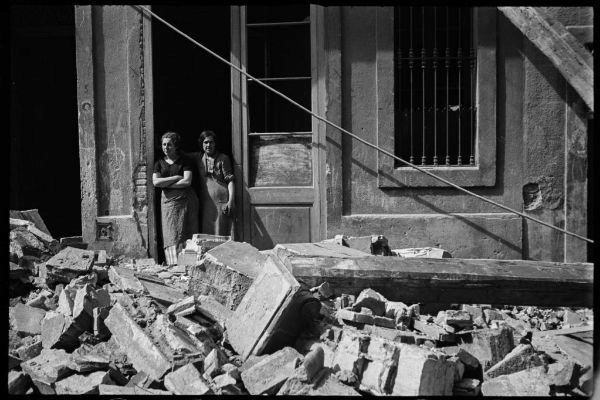- Anniversary. 80 years after the end of the Civil War: Nothing to celebrate
- Cinema: The Mole's Memory in the Civil War
- Recommendations: The Civil War, in five books
- Civil War.More information on ELMUNDO.es
The discovery in a parking lot of "red boxes" with 5,000 photographs of the Civil War by photographer Antoni Campañà now illustrates a book and shows everyday life between 1935 and 1940. Some photos, the editors have said, "flee from the epic " from other creators like Capa or Centelles.
The historian of the Autonomous University of Barcelona (UAB) Arnau Gonzàlez Vilalta, editor of "La capsa vermella" (The red box, Comanegra editorial), together with the reporter Plàcid Garcia-Planas and the photographer David Ramos, explained in an interview that "Antoni Campañà, who was mostly known for his sports or tourist photographs, hid these photos after 1939 in a garage that had been built in the 40s in Sant Cugat.
"He never wanted to show these photos and, in fact, shortly before his death in 1989, Caixa dedicated an exhibition and only showed two photographs of the Civil War," says Gonzàlez Vilalta, who says that "nobody, for almost eighty years , saw this huge archive. "
Thirty years after his death, the family decided to sell the house of Sant Cugat and one of his grandchildren wanted to visit the parking lot in case there was documentation of his grandfather and found the red boxes with glass plates, copies and negatives, " a treasure unearthed as if it were the dream of an archaeologist who was saved 'in extremis' "and whose importance the book's editors finally found, considering that" it is as interesting a background as those of Centelles or Brangulí ".
Despite the moisture and mold, the material is well preserved , and the interest of the family, the historian says, is to donate it to an institution, be it an archive or a museum, that "restores, digitizes and disseminates it, and does not I left him cornered on a shelf. "
The "forgetfulness" with which the photographer himself condemned his photographs of the war is explained, according to Gonzàlez Vilalta, because "the experience of the conflict left him traumatized and he never wanted to commercially exploit his photos in the background because he was not a photojournalist."
In his double status as a Catalan and Catholic , some photos of Campañà (Arbucias, Girona, 1906- San Cugat del Vallés, Barcelona, 1989) were used by the CNT-FAI and in the 40s by some Falangist publications.
In some of his photos, Ramos emphasizes, it is noted that Campañà feels "uncomfortable" in front of the scene he is portraying and, "beyond photographing corpses, he prefers to show his daily life, the suffering of people , how he looks adapts to circumstances, because life goes on, a realistic background, little intoxicated by the epic. "
According to Ramos, the snapshots convey that "Campañà encountered the war, but did not enjoy it as a photographer, he felt uncomfortable", a situation that contrasts with some of the snapshots taken before the conflict, in which he gives free rein to his hobby For the theater or football.
Few of his photos were published, largely because they did not pass censorship , and some of the prewar and war were published in Buenos Aires.
In the book there are many of these "sober" and "artistic" photographs and full of contrasts, such as the one he took at Diagonal in 1936 full of young Republicans parading forward and in 1939 with a fascist parade with all his pomp of troops nationals, Maghreb, Germans and Italians in the same space.
After getting married, he made the wedding trip to Nazi Germany in 1933 and there he is impregnated with Rodchenko's new vision and Central European aesthetics, which "in some of his photos of the war are almost traced to those of the Falangist magazine 'Vértice '"underlines Gonzàlez.
The editor highlights the importance of this finding, because after the war, "Centelles and Brangulí could only save part of their funds and Campañà was one of the few who managed to save everything thanks to one of those coincidences: in 1938 he was a driver and instead from going into exile he left the officer he was wearing in Vic and returned to Barcelona thinking he had done nothing. "
He surrendered at the Bruc barracks and there he met José Ortiz Echagüe, a pictorialist photographer who knew him and endorsed him: a few days later Campañà was photographing the triumphal parade of the Diagonal. Years later, when Ortiz Echagüe presided over Seat, he commissioned him to advertise the cars and the factory.
According to the criteria of The Trust Project
Know more- Girona
- Barcelona
- culture
- Photography
- history
- Spanish Civil War
- Catalonia
Literature Albert Boadella responds to Cristina Morales: "The people who fan the fire are foolish"
CataloniaInfiltrates or radical activists? Keys to some riots with CDR seal
Society 'Postcrossing' or how to recover postcards in the 21st century

